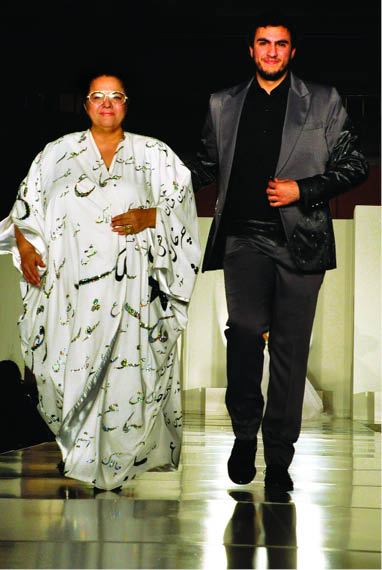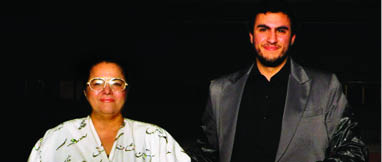The Runway Speaks:
AN INTERVIEW WITH ALEXANDRE DORRIZ

Choreographed acrobatic performances, countless lights that colored the theme of the different collections, a grand stage fit for the innovative and original couture pieces, designers Shahla and Alexandre Dorriz created a fashion show that was like an evening at the theater. As part of a charity event entitled “Desert Rose” for the St. Gregory Ladies Society, the show exhibited some of Alexandre and Shahla’s designs available for view at The Maison in Beverly Hills, for the first time on the runway. I caught up with Alexandre after the event, to ask him about his experience in creating the show.
Masa Zokaei: You’ve collaborated with your mother, Shahla Dorriz, on fashion shows. What is the experience like working with her on fashion shows rather than working on them by yourself?
Alexandre Dorriz: There’s only one thing worse than an artist single handedly coordinating an event: Two artists single handedly coordinating an event. I feel that I personally work more efficiently alone; but our creative processes are tenfold working together. There are pros and cons to it, really. A great experience nonetheless.
MZ:How was this show unique from previous fashion shows you’ve exhibited your work in?
AD: This show, “Desert Rose”, was the first show Shahla and I have choreographed alone. Setting light cues, music cues, and working with our acrobats personally. We actually had to have rehearsals for a fashion show for the first time.
MZ: During the show, I noticed women in the audience were referring to some of your work as Egyptian patterns. Is it important to you that your audience know that your work portrays Persian art and history? Does some of our work overlap into other cultures as well?
AD: My mother’s work is always skipping between countries. Any given dress could have large influence from both Indian and, for example, Egyptian style. I can really appreciate my audience more when I know they know their history. Our outfits could have anything from French influence to Russian to African. We draw inspiration from the world – we don’t stop at Persian art.
If our audience appreciates history, I think that makes it more of a challenge to impress them – I enjoy challenges.
I’m currently researching for a collection based on Russian Baroque, which is virtually non-existent and not much can be found on it. I’m drawing from the archives of architects of the Winter Palace in St. Petersburg like Rastrelli and looking into each individual room in the Hermitage to find out exactly what defines Russian Baroque. I’m creating a collection from this architectural era, since no other art medium exists from this era besides architecture and music.
MZ: I know that in the past you’ve enjoyed incorporating various types of media into your shows- including film and music. How was it like to incorporate performance art into your show?
AD: I was fairly disappointed I wouldn’t be incorporating anything cinematic in this show but really channeled that absence into my lighting, music, and of course, for the first time, performance art. I was trying to stay within the theme, “Desert Rose’, and even went past the perimeters of it incorporating some eastern European and more Balkan-type music. I tried to keep the acrobats within an ethereal sense with the music.
MZ: How do you choose your music for your shows? Whatever makes me feel something, whether nostalgia, remorse, etc., is part of the show. That’s the only way music is determined good, or bad. If it doesn’t make me feel anything, it’s expendable. Because if I can’t feel anything, how do I expect my audience to transcend?
MZ: What was it like to produce a show that was for an audience of women only?
AD: In a show for woman only, you can get away with a lot more. Especially with the kind of work Shahla and I do.
MZ: Some people may know that you are also a photographer, editor and fashion coordinator, as well as a designer. What profession is it most important that people know you for?
AD: I find it humbling people acknowledge me as a visual artist, whether it be within the realms of photography or fashion is irrelevant. Both mediums of art are inextricable. Studying photography and imaging makes me a better fashion designer and studying fashion design makes me a better fashion photographer.
MZ: Does your age ever become a factor in working in the fashion industry?
AD: Yes, very much so. I’m very fortunate to have started my craft at a very early age, but I have so much to learn still. I don’t think I’d ever want to stop continuing my education. I’d like to know my craft more than I know myself one day, and to do that it’ll take a lifetime of practice. And I’m determined to do exactly that.

